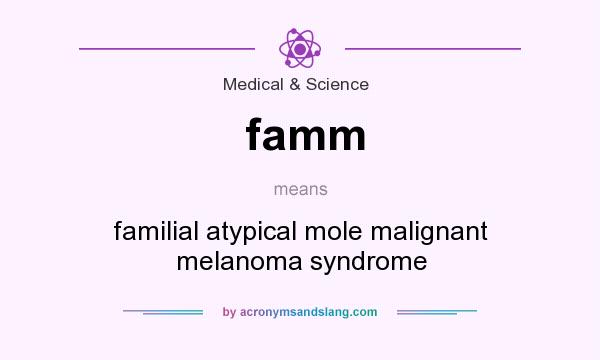A person with fammm also has one or more close relatives with melanoma.
6 lynch ht, fusaro rm, albano wa, pester j, kimberling wj, lynch jf. familial atypical multiple mole melanoma syndrome is caused by mutations in the cdkn2a gene that may be present in up to 40% of the familial cases of melanoma. What is the abbreviation for familial atypical multiple mole melanoma? (also familial atypical mole and malignant melanoma syndrome and 10 more) rating: This syndrome is difficult to define since there is no agreement on a standard phenotype, and dysplastic nevi occur in up to 50% of the general population.

This syndrome is difficult to define because there is no agreement on a standard phenotype, and dysplastic nevi occur in up to 50% of the general population.
melanomas typically occur in the skin but may rarely occur in the mouth, intestines or eye (uveal melanoma).in women, they most commonly occur on the legs, while in men they most commonly occur on the back. Dysplastic nevi are moles that possess atypical characteristics atypical moles, also called dysplastic nevi, have certain defining characteristics that may raise concern for melanoma and may require a biopsy. This syndrome is difficult to define because there is no agreement on a standard phenotype, and dysplastic nevi occur in up to 50% of the general population. 20 cm) 5 to 15. The tumor proved to be polypoid melanoma. It has been found that many of these families harbor mutations in the cdkn2a gene on chromosome 9p21. Therefore, a multidisciplinary approach is necessary in many cases. • melanoma has been diagnosed in a family member, including grandparents, aunts, uncles, and cousins • several family members have large numbers of moles (often more than 50) which may be abnormal or atypical moles. Dns defines patients with numerous dysplastic. A subset of skin cancers is associated with various hereditary cancer syndromes. Does the patient have a history of excessive sun exposure or tanning bed use? Mutations in the cdk4 gene also cause familial melanoma Such people are at markedly increased risk (25 times.
What is the abbreviation for familial atypical multiple mole melanoma? Our understanding of familial malignant melanoma was clarified by the work of reimer et al. The genetic trait of the fammm syndrome has been present for eons, but its failure to be recognized by dermatologists and oncologists is probably due to. Other risk factors include (using the mnemonic pparents) pre malignant lesions, previous melanoma, age, race, economic status, naevi numbers*, or famm syndrome (familial atypical mole and melanoma syndrome. Did the patient suffer severe sunburns during their childhood or teenage years?

The tumor proved to be polypoid melanoma.
familial atypical multiple mole melanoma (fammm) syndrome is a hereditary condition where a person has many moles (usually more than 50) that often look different from normal moles. The cutaneous manifestations of the familial atypical multiple mole melanoma (fammm) syndrome have only been recognized since the middle of the 1970s by different independent research groups. Does the patient have a familial cancer syndrome (eg, familial atypical mole and melanoma syndrome or xeroderma pigmentosum)? A 46‐year‐old man presented with a polypoid tumor on his lower back, which was excised under clinical diagnosis of soft fibroma. Superficial spreading melanoma, nodular melanoma, acral lentiginous melanoma, and lentigo maligna melanoma. 50), at least one of which is atypical and at least one of which is > A review of hereditary malignant melanoma including biomarkers in familial atypical multiple mole melanoma syndrome. The median age of onset of nmsc reported in patients with xp is 8 years. atypical moles serve as markers for melanoma risk. The first historical mention of what is now called the familial atypical multiple mole melanoma syndrome appears to be from 1820, with more reports throughout the 1950s, 1960s, and later years. Multiple, simultaneous primary skin cancers are common in these patients. Clark wh, reimer rr, greene m, et al: Such people are at markedly increased risk (25 times.
Did the patient suffer severe sunburns during their childhood or teenage years? These patients have a high risk of developing multiple primary melanomas and internal organ malignancies, especially pancreatic cancer; A family with atypical mole syndrome which manifested as polypoid melanoma in one member is reported. Therefore, a multidisciplinary approach is necessary in many cases. None, and this increases to 6.36 in those with five atypical moles.7.
Clark wh, reimer rr, greene m, et al:
A subset of skin cancers is associated with various hereditary cancer syndromes. moles can become atypical and can even develop into melanoma, a skin cancer formed by abnormal proliferation of your melanocytes. melanomas typically occur in the skin but may rarely occur in the mouth, intestines or eye (uveal melanoma).in women, they most commonly occur on the legs, while in men they most commonly occur on the back. Such people are at markedly increased risk (25 times. It is likely that both genetic causes and ultraviolet (uv) radiation have a role to play in development of atypical moles. familial atypical multiple mole melanoma (fammm) is an autosomal dominant disease characterized by the familial occurrence of malignant melanoma of the skin and multiple atypical precursor lesions. In 1991, lynch and fusaro described an association between familial multiple mole melanoma and pancreatic cancer and work continues to elucidate the. familial atypical multiple mole melanoma syndrome. This syndrome is difficult to define because there is no agreement on a standard phenotype, and dysplastic nevi occur in up to 50% of the general population. Personal history of atypical moles, familial history of melanoma and > Presence of xeroderma pigmentosum or familial atypical mole melanoma syndrome. Respectively) have been diagnosed with malignant melanoma; Most often, melanomas arise in the skin (cutaneous melanomas) and include the following histologic subtypes:
Download Familial Atypical Mole-Malignant Melanoma Images. P ancreatic carcinoma (pc) is the fourth leading cause of cancer mortality in the u.s. A review of hereditary malignant melanoma including biomarkers in familial atypical multiple mole melanoma syndrome. familial melanoma in the presence of multiple atypical nevi should raise suspicion for a germline cdkn2a mutation. Mutations in the cdk4 gene also cause familial melanoma Dns defines patients with numerous dysplastic.
This syndrome is difficult to define because there is no agreement on a standard phenotype, and dysplastic nevi occur in up to 50% of the general population malignant melanoma mole. Such people are at markedly increased risk (25 times.






